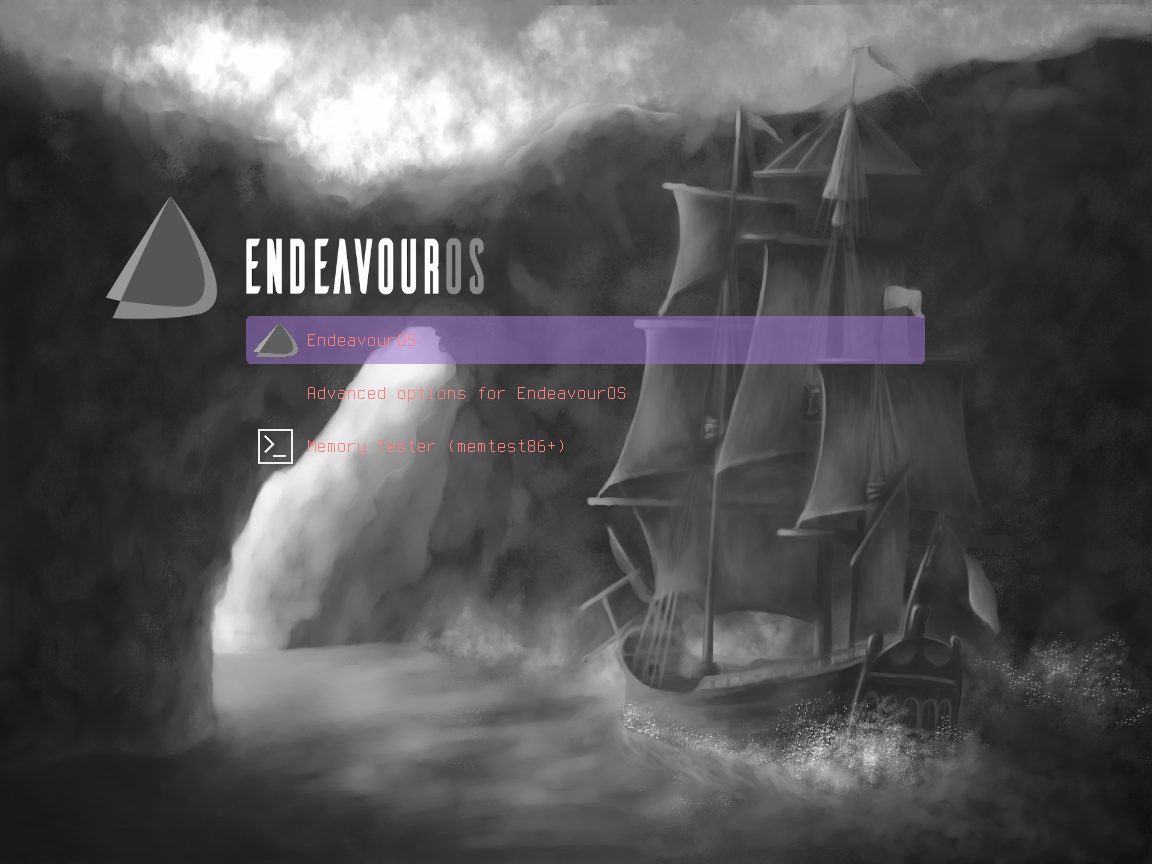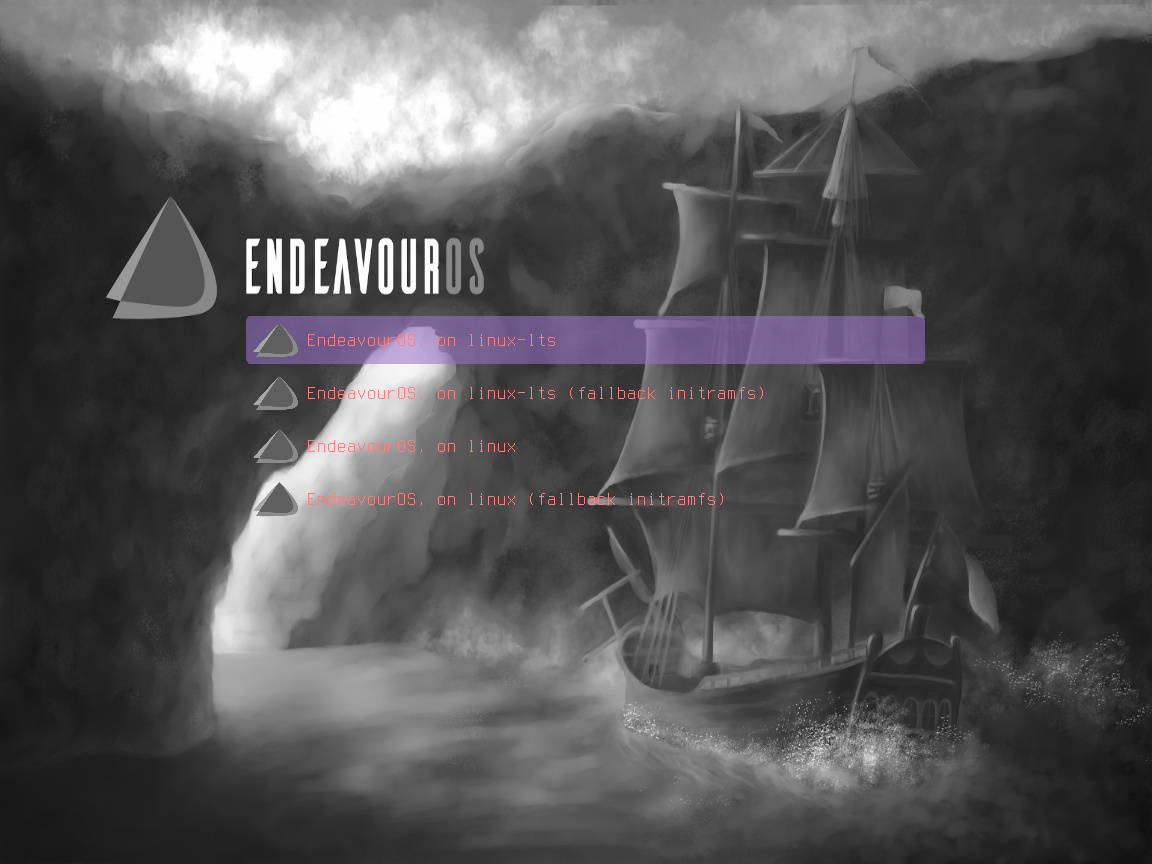Here is the output from lsbk -fm:
[uwe@HAL ~]$ lsblk -fm
NAME FSTYPE FSVER LABEL UUID FSAVAIL FSUSE% MOUNTPOINT SIZE OWNER GROUP MODE
sda 232,9G root disk brw-rw----
├─sda1 vfat FAT32 A929-6A4D 299,1M 0% /boot/efi 300M root disk brw-rw----
├─sda2 ext4 1.0 b94f97f7-5172-49d3-8f43-aed6fa978573 200,4G 3% / 223,8G root disk brw-rw----
└─sda3 swap 1 2a77001d-ae85-4e73-a7a0-8f9c199d2646 [SWAP] 8,8G root disk brw-rw----
sdb 1,8T root disk brw-rw----
└─sdb1 ext4 1.0 76c9bf53-88a4-4d70-8949-b23a590140a8 1,2T 27% /home 1,8T root disk brw-rw----
sdc 1,8T root disk brw-rw----
├─sdc1 ext4 1.0 4bdf534e-c92e-4f4f-b4a8-77d797784f9e 84,8G 8% /run/timeshi 100G root disk brw-rw----
└─sdc2 ext4 1.0 dd3668ed-5ff8-48ea-b33a-023da89b4ae3 1,7T root disk brw-rw----
[uwe@HAL ~]$
As you can see, the / partition (sda2) is the same UUID, as in the grub.config … 
#
# DO NOT EDIT THIS FILE
#
# It is automatically generated by grub-mkconfig using templates
# from /etc/grub.d and settings from /etc/default/grub
#
### BEGIN /etc/grub.d/00_header ###
insmod part_gpt
insmod part_msdos
if [ -s $prefix/grubenv ]; then
load_env
fi
if [ "${next_entry}" ] ; then
set default="${next_entry}"
set next_entry=
save_env next_entry
set boot_once=true
else
set default="${saved_entry}"
fi
if [ x"${feature_menuentry_id}" = xy ]; then
menuentry_id_option="--id"
else
menuentry_id_option=""
fi
export menuentry_id_option
if [ "${prev_saved_entry}" ]; then
set saved_entry="${prev_saved_entry}"
save_env saved_entry
set prev_saved_entry=
save_env prev_saved_entry
set boot_once=true
fi
function savedefault {
if [ -z "${boot_once}" ]; then
saved_entry="${chosen}"
save_env saved_entry
fi
}
function load_video {
if [ x$feature_all_video_module = xy ]; then
insmod all_video
else
insmod efi_gop
insmod efi_uga
insmod ieee1275_fb
insmod vbe
insmod vga
insmod video_bochs
insmod video_cirrus
fi
}
if [ x$feature_default_font_path = xy ] ; then
font=unicode
else
insmod part_gpt
insmod ext2
set root='hd0,gpt2'
if [ x$feature_platform_search_hint = xy ]; then
search --no-floppy --fs-uuid --set=root --hint-ieee1275='ieee1275//disk@0,gpt2' --hint-bios=hd0,gpt2 --hint-efi=hd0,gpt2 --hint-baremetal=ahci0,gpt2 b94f97f7-5172-49d3-8f43-aed6fa978573
else
search --no-floppy --fs-uuid --set=root b94f97f7-5172-49d3-8f43-aed6fa978573
fi
font="/usr/share/grub/unicode.pf2"
fi
if loadfont $font ; then
set gfxmode=auto
load_video
insmod gfxterm
set locale_dir=$prefix/locale
set lang=de_DE
insmod gettext
fi
terminal_input console
terminal_output gfxterm
if [ x$feature_timeout_style = xy ] ; then
set timeout_style=menu
set timeout=5
# Fallback normal timeout code in case the timeout_style feature is
# unavailable.
else
set timeout=5
fi
### END /etc/grub.d/00_header ###
### BEGIN /etc/grub.d/10_linux ###
menuentry 'EndeavourOS, on linux-lts' --class endeavouros --class gnu-linux --class gnu --class os $menuentry_id_option 'gnulinux-linux-lts-advanced-b94f97f7-5172-49d3-8f43-aed6fa978573' {
savedefault
load_video
set gfxpayload=keep
insmod gzio
insmod part_gpt
insmod ext2
set root='hd0,gpt2'
if [ x$feature_platform_search_hint = xy ]; then
search --no-floppy --fs-uuid --set=root --hint-ieee1275='ieee1275//disk@0,gpt2' --hint-bios=hd0,gpt2 --hint-efi=hd0,gpt2 --hint-baremetal=ahci0,gpt2 b94f97f7-5172-49d3-8f43-aed6fa978573
else
search --no-floppy --fs-uuid --set=root b94f97f7-5172-49d3-8f43-aed6fa978573
fi
echo 'Loading kernel linux-lts ...'
linux /boot/vmlinuz-linux-lts root=UUID=b94f97f7-5172-49d3-8f43-aed6fa978573 rw quiet loglevel=3 nowatchdog
echo 'Loading initial ramdisk ...'
initrd /boot/intel-ucode.img /boot/initramfs-linux-lts.img
}
menuentry 'EndeavourOS, on linux-lts (fallback initramfs)' --class endeavouros --class gnu-linux --class gnu --class os $menuentry_id_option 'gnulinux-linux-lts-fallback-b94f97f7-5172-49d3-8f43-aed6fa978573' {
savedefault
load_video
set gfxpayload=keep
insmod gzio
insmod part_gpt
insmod ext2
set root='hd0,gpt2'
if [ x$feature_platform_search_hint = xy ]; then
search --no-floppy --fs-uuid --set=root --hint-ieee1275='ieee1275//disk@0,gpt2' --hint-bios=hd0,gpt2 --hint-efi=hd0,gpt2 --hint-baremetal=ahci0,gpt2 b94f97f7-5172-49d3-8f43-aed6fa978573
else
search --no-floppy --fs-uuid --set=root b94f97f7-5172-49d3-8f43-aed6fa978573
fi
echo 'Loading kernel linux-lts ...'
linux /boot/vmlinuz-linux-lts root=UUID=b94f97f7-5172-49d3-8f43-aed6fa978573 rw quiet loglevel=3 nowatchdog
echo 'Loading initial ramdisk ...'
initrd /boot/initramfs-linux-lts-fallback.img
}
menuentry 'EndeavourOS, on linux' --class endeavouros --class gnu-linux --class gnu --class os $menuentry_id_option 'gnulinux-linux-advanced-b94f97f7-5172-49d3-8f43-aed6fa978573' {
savedefault
load_video
set gfxpayload=keep
insmod gzio
insmod part_gpt
insmod ext2
set root='hd0,gpt2'
if [ x$feature_platform_search_hint = xy ]; then
search --no-floppy --fs-uuid --set=root --hint-ieee1275='ieee1275//disk@0,gpt2' --hint-bios=hd0,gpt2 --hint-efi=hd0,gpt2 --hint-baremetal=ahci0,gpt2 b94f97f7-5172-49d3-8f43-aed6fa978573
else
search --no-floppy --fs-uuid --set=root b94f97f7-5172-49d3-8f43-aed6fa978573
fi
echo 'Loading kernel linux ...'
linux /boot/vmlinuz-linux root=UUID=b94f97f7-5172-49d3-8f43-aed6fa978573 rw quiet loglevel=3 nowatchdog
echo 'Loading initial ramdisk ...'
initrd /boot/intel-ucode.img /boot/initramfs-linux.img
}
menuentry 'EndeavourOS, on linux (fallback initramfs)' --class endeavouros --class gnu-linux --class gnu --class os $menuentry_id_option 'gnulinux-linux-fallback-b94f97f7-5172-49d3-8f43-aed6fa978573' {
savedefault
load_video
set gfxpayload=keep
insmod gzio
insmod part_gpt
insmod ext2
set root='hd0,gpt2'
if [ x$feature_platform_search_hint = xy ]; then
search --no-floppy --fs-uuid --set=root --hint-ieee1275='ieee1275//disk@0,gpt2' --hint-bios=hd0,gpt2 --hint-efi=hd0,gpt2 --hint-baremetal=ahci0,gpt2 b94f97f7-5172-49d3-8f43-aed6fa978573
else
search --no-floppy --fs-uuid --set=root b94f97f7-5172-49d3-8f43-aed6fa978573
fi
echo 'Loading kernel linux ...'
linux /boot/vmlinuz-linux root=UUID=b94f97f7-5172-49d3-8f43-aed6fa978573 rw quiet loglevel=3 nowatchdog
echo 'Loading initial ramdisk ...'
initrd /boot/initramfs-linux-fallback.img
}
### END /etc/grub.d/10_linux ###
### BEGIN /etc/grub.d/20_linux_xen ###
### END /etc/grub.d/20_linux_xen ###
### BEGIN /etc/grub.d/30_os-prober ###
### END /etc/grub.d/30_os-prober ###
### BEGIN /etc/grub.d/40_custom ###
# This file provides an easy way to add custom menu entries. Simply type the
# menu entries you want to add after this comment. Be careful not to change
# the 'exec tail' line above.
### END /etc/grub.d/40_custom ###
### BEGIN /etc/grub.d/41_custom ###
if [ -f ${config_directory}/custom.cfg ]; then
source ${config_directory}/custom.cfg
elif [ -z "${config_directory}" -a -f $prefix/custom.cfg ]; then
source $prefix/custom.cfg;
fi
### END /etc/grub.d/41_custom ###
my /etc/fstab:
# /etc/fstab: static file system information.
#
# Use 'blkid' to print the universally unique identifier for a device; this may
# be used with UUID= as a more robust way to name devices that works even if
# disks are added and removed. See fstab(5).
#
# <file system> <mount point> <type> <options> <dump> <pass>
UUID=A929-6A4D /boot/efi vfat umask=0077 0 2
UUID=b94f97f7-5172-49d3-8f43-aed6fa978573 / ext4 defaults,noatime 0 1
UUID=76c9bf53-88a4-4d70-8949-b23a590140a8 /home ext4 defaults,noatime 0 2
UUID=dd3668ed-5ff8-48ea-b33a-023da89b4ae3 /media/backup ext4 defaults,noauto,user,x-gvfs-show,x-gvfs-name=Backup 0 0
UUID=2a77001d-ae85-4e73-a7a0-8f9c199d2646 none swap defaults 0 0
tmpfs /tmp tmpfs defaults,noatime,mode=1777 0 0



